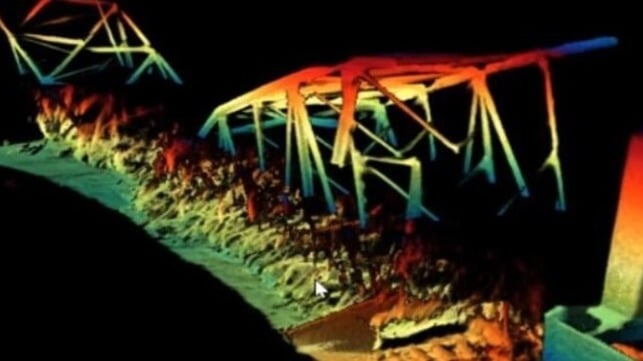Contractors Will Cut Baltimore Bridge Wreckage With Hydraulic Shears

In a press briefing Wednesday, the head of the U.S. Army Corps of Engineers' Baltimore district gave fresh details on the plan to remove the wreckage of the Francis Scott Key Bridge. The steel through-truss bridge collapsed on March 26 after a container ship hit one of its piers, and the Navy Supervisor of Diving and Salvage is coordinating efforts to remove the resulting wreckage from the navigation channel.
According to Pinchasin, the next step for clearing the channel is to cut a 1,500-ton section of the center span into two pieces of about 750 tonnes each. These will be small enough to pick up with the largest crane available. (Some foreign-flag crane ships might be capable of a single-piece 1,500 tonne hoist, but the largest crane barge on the East Coast is limited to 1000 short tons.)
In order to cut the 1,500-ton section in half, a crane with a bucket dredge is working on digging a hole through the crumpled road surface of the span, she said. Once that's done, there will be enough access for divers to place hydraulic shears on the thick steel chords on the bottom of the bridge. When the divers are out of the way at a safe distance, the shears will be activated and the underwater section will be cut safely in two.
The unified command still plans to reopen a 35-foot-deep channel by the end of April and the full 50-foot channel by the end of May, Col. Pinchasin confirmed, adding that the timeline is firm and is based on rigorous engineering analyses.
In a statement Wednesday, Senator Ted Cruz (R-TX) criticized the unified command's pace, comparing it unfavorably to the speed of America's primary competitor.
“Given the importance of the port to the economy, one has to wonder - 'is our country treating this like an emergency?' I can’t help but think that China would have cleared the wreckage in days. I hope this episode doesn’t become another punchline about a nation in decline," Cruz said.
Separately, the National Transportation Safety Board's investigative team still remains on site and working in Baltimore, chair Jennifer Homendy said in a reconfirmation hearing in the Senate on Wednesday. The NTSB's staff are still interviewing crewmembers and collecting information. Homendy pleaded with senators for more funding for her staff, noting that she has to choose between basic maintenance on the NTSB office building or hiring enough marine investigators.
